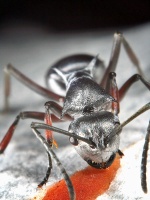SOMETHING ABOUT ANTS.
AN Englishman who has studied insects and plants for many years, has just written a book about ants.
He says that he had read so many stories about them that he thought were not true that he decided to watch them for himself.
He made some nests of glass, with one side of wood, and kept them in boxes or on stands; then he went out of doors and dug up an ant's nest, and put it over one of his nests, which had water around it, and was between two plates of glass, so that the water could not go away into the air.
After a while, when the ants' own nest grew dry, they went to the moist earth, near the water, and began to dig a new home.
One family has lived in the same glass case for eight years, and two queens have lived all that time; longer than some of you.
But, you say, how did the man know that they were the same queens
He marked their backs with paint, which lasted a long time, until their friends cleaned it off little by little. Then he put on more.
Ants, bees, and wasps belong to the great family of membrane-winged insects.
If you look at a bee, you will see that its wings are somewhat like those of a fly, but that it has twice as many.
"But ants have no wings," you say. Some ants never have them.
The queens and workers, who take care of the young, are without them. The males, however, can fly.
Sir John, the- man who observed the ants, is busy and away from home much of the time; but his young daughters and their teacher help him, by looking at the ants every hour.
Ants like honey and meat; and in their wild state live on other insects, or the sweet juices which are found in plant-lice, which are sometimes called ants' cows.
Sir John has spent much time in watching ants' behavior to each other.
One day a working ant had been hurt, although she was still able to feed. After a while another ant came up to her, crossed antennae with her and began to feed. Afterwards three other ants went to get their syrup, but not one of them took any notice of their poor sick sister. The same thing happened several times.
One day, an ant had been almost drowned, and some- of the others, whose backs Sir John had painted, went by eighteen or twenty times without noticing it.
On another day, after three had gone by with-out noticing another half-drowned ant, a fourth picked her up and carried her to the nest.
One poor ant had never had any antennae, and for a long time did not leave the nest. One day,
Sir John found that she had wandered out and lost her way. She soon met some ants of another kind, who attacked her and. wounded her. After a while one of her own family came by, picked her up and carried her home.
Ants know their friends after they have been separated from them for a long time. Sir John took half the ants from a nest, and after six weeks marked one and put it into its old home with a stranger. The ants in the nest flew at the stranger, but took no notice of their old friend.
He did the same thing about once a week for a month, and every time the stranger was killed or driven out.
At last, after a year and nine months, he put back three ants into the old nest, and they were not noticed at all. Sometimes these ants were attacked by young ones who had not known them, but they were never killed or driven out of the nest.
Sometimes he put full-grown ants into a nest from which they had been taken in the chrysalis state, and found that they were almost always kindly treated, while strangers were attacked.
Ants have many strong enemies. One of them, called the Great Ant-eater, is shown in the picture.
He lives in South America. He has a long head, but no teeth. His hair is coarse and brown, with some gray on his face. The claws on his fore feet are very long, and when he wants to walk, he doubles them under, just as you would turn your fingers down on the palm of your hand. When he goes to bed, he does not crawl into a hole, but curls up under his great, bushy tail, so that he looks like a bundle of hay thrown down on the ground.
Select
